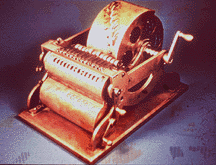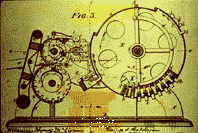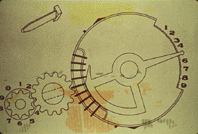|
The era of Antiquity (continued) 1846 - 1873 The telephone and typewriter were invented in this period. The industrial diligence of developing devices has become unstoppable and concequently the industrial revolution began. There was a lot of political turmoil especially in Europe and Asia, which lead to World War I. |
pre history | antiquity
| pre industrial era | industrial
era
1620 -
1672 - 1773 - 1810
- 1830 - 1846
- 1874
| Related Articles |
| Logarithm Boolean Algebra |
| Related Resources |
|
|
![]() Alexander
Bain uses perforated tape to transmit telegrams.
The tape is nicknamed 'ticker tape' because of the
ticking sound made by the telegraph. This procedure sped up the transmission
of information very much. And until well into the 20th century companies used
this method for transmitting information.
Alexander
Bain uses perforated tape to transmit telegrams.
The tape is nicknamed 'ticker tape' because of the
ticking sound made by the telegraph. This procedure sped up the transmission
of information very much. And until well into the 20th century companies used
this method for transmitting information.
These perforated tapes, or punch tapes, will also be adopted for the output of computer. The teletype (telex) terminals accepted only this kind of tape and were the sole way to communicate with computers. Thus data the punched tape will be used for the decades to come in dataprocessing.
![]() George
Boole (1815-1864), a British mathematician, proved in his
George
Boole (1815-1864), a British mathematician, proved in his
the relation between mathematics and logic; his algebra of logic (BOOLEAN
algebra or binary logic) made it possible to treat a number of logical
problems as algebraic operations.
This was a breakthrough for mathematics and Boole was the first to prove that
logic is part of mathematics and not of philosophy as was commonly accepted
by scientists of this era.
![]() Charles Babbage
completed this and the next few years 21 drawings of the second
generation Difference Engine but the machine will never be realized.(19)
Charles Babbage
completed this and the next few years 21 drawings of the second
generation Difference Engine but the machine will never be realized.(19)
![]() Ferdinand Braun, a professor in
physics at Marburg (Germany) constructed the first solid
state to detect a radio signal.
Ferdinand Braun, a professor in
physics at Marburg (Germany) constructed the first solid
state to detect a radio signal.
![]() The calculator disc invented by William Oughtred was
simplified by Amedee Mannhein (Fr.) and took the
form of a ruler that came into common use.
The calculator disc invented by William Oughtred was
simplified by Amedee Mannhein (Fr.) and took the
form of a ruler that came into common use.
![]() Victor Schilt exhibited a punch
key driven calculator (adding machine) during the Crystal Palace exhibition
in London (UK). This machine displayed no 'zero'.
Victor Schilt exhibited a punch
key driven calculator (adding machine) during the Crystal Palace exhibition
in London (UK). This machine displayed no 'zero'.
![]() Nov 27, Ada Lovelace (b.1815), Lord Byron's
daughter and is the inventor of computer programming, was bled to death by physicians
at age 36, she had cancer of the uterus. She helped Charles Babbage develop
his "Analytical Engine," that performed mathematical calculations
through the use of punched cards.(9)
Nov 27, Ada Lovelace (b.1815), Lord Byron's
daughter and is the inventor of computer programming, was bled to death by physicians
at age 36, she had cancer of the uterus. She helped Charles Babbage develop
his "Analytical Engine," that performed mathematical calculations
through the use of punched cards.(9)
![]() The Scheutz Difference Engine completed:
the world's first printing calculator.
The Scheutz Difference Engine completed:
the world's first printing calculator.
| George Boole 1815–1864 describes his system for symbolic and logical reasoning: "An Investigation of the Laws of Thought..." (when he was 39) a work that is of fundamental importance in the study of the foundations of pure mathematics and is also at the basis of computer technology. (6) His Boolean algebra is based on simple logical decisions like:
More algebraic: (A <> B) > 10 AND (A < B) > 0 This statement means: A is different from B and where A can be smaller than B the latter should be larger than 0 where the difference is always larger than (positive) 10 One can see that the Boolean algebra is more elegant and easier to understand.
|
 |
![]() Heinrich Geissler
Igelshieb developed a vacuum pump. He used mercury as medium because of its
high density. With this pump, one could reach alsmost absolute vacuum and this
was something the industry had been waiting for. This vacuum technique lead
to the development of the Cathode-Ray Tube (CRT, the standard television screen
is a CRT). Later, the existence of the electron will be proven with the help
of this same CRT device.
Heinrich Geissler
Igelshieb developed a vacuum pump. He used mercury as medium because of its
high density. With this pump, one could reach alsmost absolute vacuum and this
was something the industry had been waiting for. This vacuum technique lead
to the development of the Cathode-Ray Tube (CRT, the standard television screen
is a CRT). Later, the existence of the electron will be proven with the help
of this same CRT device.
The first transatlantic cable between the UK and USA is a fact. After a few years of toiling and disappointments the world became a lot smaller. Communication between two continents is now possible with only a few seconds of delay. Although the laying of this first cable was seen as a landmark event in society, it was a technical failure. It only remained in service a few days. The ones laid in 1866 and on will be a lot more succesfull. Some will even remain in operation for over a hundred years!
![]()
![]() Sir Charles Wheatstone - also the inventor of the accordion
- introduced the first application of paper tapes as a medium for the preparation,
storage, and transmission of data.
Sir Charles Wheatstone - also the inventor of the accordion
- introduced the first application of paper tapes as a medium for the preparation,
storage, and transmission of data.
His paper tape used two rows of holes to represent Morse's dots and dashes.
Outgoing messages could be prepared off-line on paper tape and transmitted later.
(4)
![]() The first Tabulating Machine is purchased by the Dudly Observatory
in Albany, New York. It is used to produce a set of astronomical tables. The
Director of the observatory is fired for his extravagant purchase and the machine
is never used again. It eventually ended up in a museum.(1)
The first Tabulating Machine is purchased by the Dudly Observatory
in Albany, New York. It is used to produce a set of astronomical tables. The
Director of the observatory is fired for his extravagant purchase and the machine
is never used again. It eventually ended up in a museum.(1)
![]() Giovanni Casselli brought the
first fax machine on the market: the Pantelegraph.
Giovanni Casselli brought the
first fax machine on the market: the Pantelegraph.
![]() Johann Philipp Reis, a Hessian teacher, demonstrated the first
electrical transmission of speech. Unfortunately, he failed to find support
in Germany.(5)
Johann Philipp Reis, a Hessian teacher, demonstrated the first
electrical transmission of speech. Unfortunately, he failed to find support
in Germany.(5)

![]() The TYPEWRITER is introduced and is one of those great inventions
that will revolutionize administration and communication. Writing business letters
by hand will disappear within a few years. At left is an early typewriter called
the 'writing ball', invented by the Danish Maling Hansen in 1867.
The TYPEWRITER is introduced and is one of those great inventions
that will revolutionize administration and communication. Writing business letters
by hand will disappear within a few years. At left is an early typewriter called
the 'writing ball', invented by the Danish Maling Hansen in 1867.
![]() First QWERTY keyboard
First QWERTY keyboard
|
![]() William Stanley Jevons build the first practical logical machine
that is based on the priciples of the Boolean algebra(25).
He was professor of logic a Owenn's College and described this machine in Phil.
Trans. Roy. Soc. (1870), in a paper "On the Mechanical performance of Logical
Inference", and in his "Principles of Science" (1873).
William Stanley Jevons build the first practical logical machine
that is based on the priciples of the Boolean algebra(25).
He was professor of logic a Owenn's College and described this machine in Phil.
Trans. Roy. Soc. (1870), in a paper "On the Mechanical performance of Logical
Inference", and in his "Principles of Science" (1873).
The machine was, in Jevons own words, "capable of exhibiting an answer
to any question which may be put to it concerning the possible combinations
which form any class".(3)
Charles Babbage produces a prototype of the Analytical Engine's printer and mill, demonstrating this got him some seed money to start his project.

![]() In 1873, Frank Baldwin applies for
a patent for a machine "which at all times has the capacity to add, subtract,
multiply and divide with no resetting of the mechanism and with no form of conversion
for any of the processes." While employed by a lumber company, Baldwin
had been asked to repair a Thomas Machine, which
is when he probably got the idea to build his own.
In 1873, Frank Baldwin applies for
a patent for a machine "which at all times has the capacity to add, subtract,
multiply and divide with no resetting of the mechanism and with no form of conversion
for any of the processes." While employed by a lumber company, Baldwin
had been asked to repair a Thomas Machine, which
is when he probably got the idea to build his own.

He replaced the Leibnitz and Thomas cylinders with a single cylinder from whose periphery a variable number of teeth (1 through 9) protrude according to the motion of the setting lever. The levers project through slots at the front of the machine.

When the lever is set, corresponding numbers of teeth project from the wheel.

With a crank of the handle, the projecting teeth gear with a cogwheel, which activates a digit wheel, and the numbers corresponding to the projecting teeth appear in the register.
![]() Baldwin joined forces with Monroe in 1912
and formed the Monroe Calculator Company.
A pioneer in electric adding machines since 1922, the firm is still in this
business.
Baldwin joined forces with Monroe in 1912
and formed the Monroe Calculator Company.
A pioneer in electric adding machines since 1922, the firm is still in this
business.
| Last Updated on June 22, 2004 | For suggestions please mail the editors |
Footnote and References